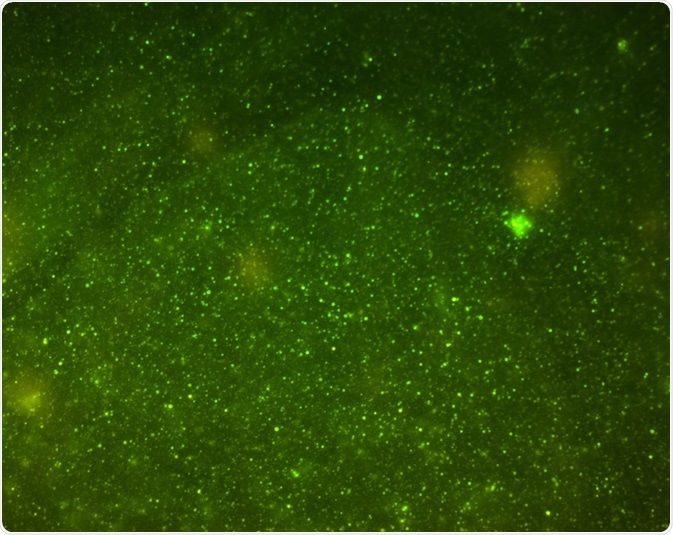Flow cytometry is a versatile cell analysis technique that can be used to analyze multiple cell types. Combining flow cytometry with various other techniques can further increase its versatility and provide more detailed data.
 DavidBautista | Shutterstock
DavidBautista | Shutterstock
The principles of flow cytometry and cell counting
What is flow cytometry?
Flow cytometry is a technique that involves passing cells suspended in a liquid through a laser, while the scattering of light is detected and processed in real-time. Flow cytometry also measures the fluorescence intensity of cells. The information gained from flow cytometry can be used to distinguish the various characteristics of cells, such as size, morphology, cell surface markers, intracellular ions, protein expression, DNA content, as well as various homeostatic functions.
Flow cytometry can be used to measure multiple parameters of a cell simultaneously, which is achieved by tagging different cell parameters with different fluorophores. Flow cytometry can also measure multiple different cell types simultaneously, which is termed ‘multiplexing’. Multiplexing is achieved by tagging the different cell types with different fluorophores and can be used to study genes, protein function, and molecular assembly in cells.
Improvements to flow cytometry cell counting
Fluorescent cell barcoding allows more analytes to be passed through the flow cytometer, which increases the efficiency of flow cytometry. Each cell passed through the flow cytometer is labeled with a different barcode of fluorescence intensity and emission wavelength.
This method of barcoding has been used to screen libraries of cells for inhibitors of T-cell receptor and cytokine signaling. This was used to test for efficacy and selectivity of certain drugs on various aspects of the immune system.
Using only three different fluorophores, it is possible to analyze 96 different analytes simultaneously. As a result, increasing the number of dyes used will increase the number of possible analytes exponentially.
Multiple laser flow cytometers in combination with new probes and instrumentation have allowed for up to 17 fluorescence emission to be used simultaneously. This allows for the analysis of a large number of analytes, which can give extremely detailed and comprehensive data sets.
Flow cytometry sample handling
In the early days of flow cytometry analysis, only about two samples per minute were amenable for analysis. However, continuous research and development of the flow cytometry process have increased flow cytometry throughput, making it possible to analyze as much as 40-100 samples a minute. This allows for a set of 384 wells to be analyzed every 10 minutes. The input cell concentrations for this are 1-20 million cells per milliliter, with a 4-decade range of fluorescence intensity
The high throughput of flow cytometry has allowed for data sets on very specific cell processes to be made (e.g. ligand and G protein-coupled receptor interactions and the resulting signaling).
Combining flow cytometry with other cell analysis techniques
Combining flow cytometry and mass cytometry
Flow cytometry and mass cytometry were used together to analyze cells for biomarkers of chronic graft vs host disease (cGVHD). For that purpose, blood was taken from patients exhibiting cGVHD and peripheral blood mononuclear cells (PBMCs) were removed from the plasma and then stained.
A total of 44 antibodies for various markers of cGVHD were used during this study. After staining the PBMCs they were analyzed using fluorescence-activated cell sorting (which is a specialized type of flow cytometry).
PMBC samples from patients were treated with various chemicals before being analyzed using mass cytometry. Data from the flow cytometry and mass cytometry was analyzed to assess the cGVHD status of the patients. The analysis found that lower levels of mucosal-associated T cells were seen in patients with severe cGVHD.
On the other hand, patients with moderate and severe cGVHD showed a higher active T cell population and higher expression of chemokines and cytokines involved in an active immune response. The findings from this analysis will aid in understanding cGVHD and providing better treatment options for it.
Combining flow cytometry and fine needle aspiration cytology
Flow cytometry analysis and fine needle aspiration cytology (FNAC) were used to diagnose and classify non-Hodgkin lymphoma (NHL). In one study, FNAC smears were prepared and stained. The material was then collected for flow cytometric immunophenotyping (FCI), while the samples were processed and a panel of antibodies was used for the immunotyping. The cytology findings and the FCI data were analyzed in conjunction to diagnose and classify NHL in accordance with the existing classifications.
The material collected for FCI was also used for dual-color flow cytometry analysis. This material was prepared and tagged with two different fluorophores, and antibodies for various CD proteins were used. The analysis of all the data collected allowed for 79% of NHL cases analyzed to be sub-classed.
The subclasses included small lymphatic cell lymphoma, mantel cell lymphoma, and large B lymphoma, as well as many others, which is extremely important for the field of hematology.
Further Reading